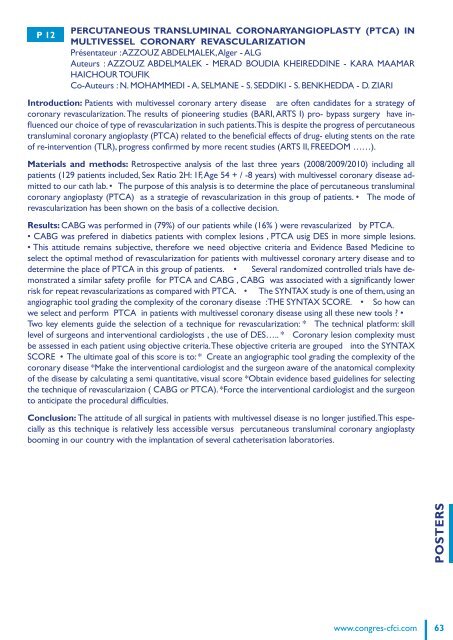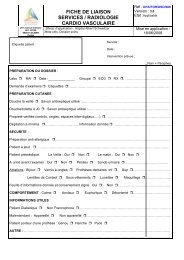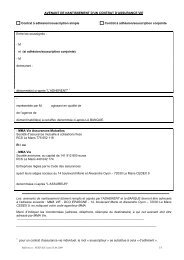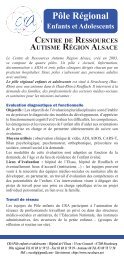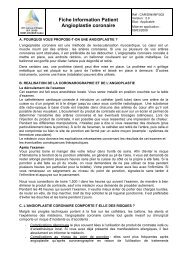Francophone - Webagoo.eu
Francophone - Webagoo.eu
Francophone - Webagoo.eu
You also want an ePaper? Increase the reach of your titles
YUMPU automatically turns print PDFs into web optimized ePapers that Google loves.
P 12<br />
PERCUTANEOUS TRANSLUMINAL CORONARYANGIOPLASTY (PTCA) IN<br />
MULTIVESSEL CORONARY REVASCULARIZATION<br />
Présentat<strong>eu</strong>r : AZZOUZ ABDELMALEK, Alger - ALG<br />
Aut<strong>eu</strong>rs : AZZOUZ ABDELMALEK - MERAD BOUDIA KHEIREDDINE - KARA MAAMAR<br />
HAICHOUR TOUFIK<br />
Co-Aut<strong>eu</strong>rs : N. MOHAMMEDI - A. SELMANE - S. SEDDIKI - S. BENKHEDDA - D. ZIARI<br />
Introduction: Patients with multivessel coronary artery disease are often candidates for a strategy of<br />
coronary revascularization. The results of pioneering studies (BARI, ARTS I) pro- bypass surgery have influenced<br />
our choice of type of revascularization in such patients. This is despite the progress of percutaneous<br />
transluminal coronary angioplasty (PTCA) related to the beneficial effects of drug- eluting stents on the rate<br />
of re-intervention (TLR), progress confirmed by more recent studies (ARTS II, FREEDOM ……).<br />
Materials and methods: Retrospective analysis of the last three years (2008/2009/2010) including all<br />
patients (129 patients included, Sex Ratio 2H: 1F, Age 54 + / -8 years) with multivessel coronary disease admitted<br />
to our cath lab. • The purpose of this analysis is to determine the place of percutaneous transluminal<br />
coronary angioplasty (PTCA) as a strategie of revascularization in this group of patients. • The mode of<br />
revascularization has been shown on the basis of a collective decision.<br />
Results: CABG was performed in (79%) of our patients while (16% ) were revascularized by PTCA.<br />
• CABG was prefered in diabetics patients with complex lesions , PTCA usig DES in more simple lesions.<br />
• This attitude remains subjective, therefore we need objective criteria and Evidence Based Medicine to<br />
select the optimal method of revascularization for patients with multivessel coronary artery disease and to<br />
determine the place of PTCA in this group of patients. • Several randomized controlled trials have demonstrated<br />
a similar safety profile for PTCA and CABG , CABG was associated with a significantly lower<br />
risk for repeat revascularizations as compared with PTCA. • The SYNTAX study is one of them, using an<br />
angiographic tool grading the complexity of the coronary disease : THE SYNTAX SCORE. • So how can<br />
we select and perform PTCA in patients with multivessel coronary disease using all these new tools ? •<br />
Two key elements guide the selection of a technique for revascularization: * The technical platform: skill<br />
level of surgeons and interventional cardiologists , the use of DES….. * Coronary lesion complexity must<br />
be assessed in each patient using objective criteria. These objective criteria are grouped into the SYNTAX<br />
SCORE • The ultimate goal of this score is to: * Create an angiographic tool grading the complexity of the<br />
coronary disease *Make the interventional cardiologist and the surgeon aware of the anatomical complexity<br />
of the disease by calculating a semi quantitative, visual score *Obtain evidence based guidelines for selecting<br />
the technique of revascularizaion ( CABG or PTCA). *Force the interventional cardiologist and the surgeon<br />
to anticipate the procedural difficulties.<br />
Conclusion: The attitude of all surgical in patients with multivessel disease is no longer justified. This especially<br />
as this technique is relatively less accessible versus percutaneous transluminal coronary angioplasty<br />
booming in our country with the implantation of several catheterisation laboratories.<br />
POSTERS<br />
www.congres-cfci.com<br />
63


